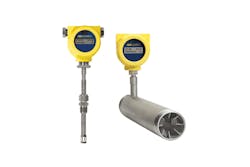FCI’s compact thermal flowmeter line has been expanded and improved with an advanced electronics design that features the addition of HART version 7 digital bus communication and more. The SIL 1-compliant models ST51A, ST75A and ST75AV thermal mass flowmeters provide users with an economical yet reliable solution to measuring air or gases in demanding industrial process and plant applications.
The ST51A flowmeter is an insertion-style instrument designed for use in pipe diameters larger than 2 in. (51 mm), and it is optimized for flow measurement of air, compressed air, nitrogen, natural gas, digester gas and all other biogases. It measures flow from 0.3 to 400 standard ft/second (0.08 to 122 m/second) with turndown ratio of 100:1 and with accuracy of ±1% reading, ±0.5% full scale.
The ST75A and ST75VA flowmeters are inline-style instruments designed for use in pipe diameters from 0.25 to 2 in. (6 to 51 mm); they support applications in air, all inert gases, natural gas and other hydrocarbon gases. They feature a wide 100:1 turndown ratio and measure from 0.01 to 559 standard cu ft/minute (0.01 to 950 normal cu m/minute) with accuracy of ±1% reading, ± 0.5% full scale.
The standard ST51A, ST75A and ST75AV outputs are dual 4-20mA. They meet NAMUR NE43 and feature a 500-Hz pulse. The electronics are housed in an IP67 rated, dual-cable port transmitter enclosure available in aluminum or a new stainless steel version. The transmitter can be mounted directly to the flow sensor or remotely mounted up to 100 ft (30 m) away.
The ST51A, ST75A and ST75AV flowmeters have the CE mark, and Div. 1/Zone 1 Ex agency approvals of FM, FMc, ATEX and IECEx. They have also been independently verified to meet IEC 61508 for Safety Integrity Level (SIL-1) rating.



